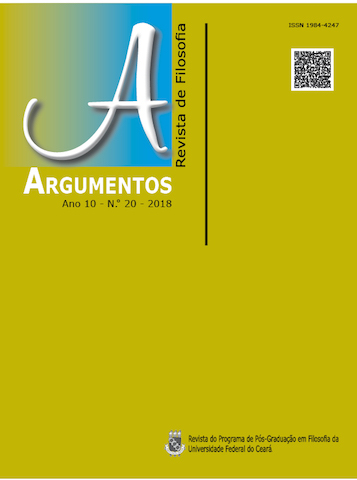A logic to support the experimental error in physics
Keywords:
History of science. Scientific experiments. Paraclassical logic.Abstract
In this paper propose the use of a non-classical logical to support the experimental error of the measurement made in physical science (or any other science that uses measurements). Begining with a brief historical presentation of the physical method, emphasis on the importance of experiments and measurement in this science. Subsequently, we emphasize the presence of errors in any measurement done in any experiment (error that cannot be avoided, since it is ‘linked’ to the own device that we use to make the measurement, as we shall see). In sequence, we show how this error can become problematic when viewed from the classical theory of models, based on classical logic. From this, is proposed the use of a non-classic logic to address this problem: the know paraclassic logic (which is a kind of paraconsistent logic). Is exhibit the formal counterpart of this alternative logic, some theorems and results, and finally is exhibit how the ‘logical problem’ of the error in scientific experiments can best be handle with this non-classical tool.Downloads
References
BRECHT, B. (1938-1939). Vida de Galileu in Bertold Brecht: teatro completo em 12 volumes, v. 6, São Paulo: Paz e Terra S.A., 1991. p. 51-171.
BRENNAN, R. P., Gigantes da Física: uma história da física moderna em oito biogra- fias. Rio de Janeiro: Zahar Editor, 2003.
CARTWRIGHT, N. How the laws of physics lie. Oxford University Press, 1983. CHALMERS, A. F. O que é Ciência, afinal? São Paulo: Brasiliense, 1999.
DA COSTA, N. C. A. E DÓRIA, F. A., On Jáskowski discoursive lógic in Studia lógica, n. 54, 1995, p. 36-60.
DA COSTA, N. C. A. E KRAUSE, D. Remarks on the applications of paraconsistent logic to physics. In: Pietrocola, M. e Freire, O. (Eds.). Filosofia, ciência e história. São Paulo: Discurso Editorial, 2005. p. 337-359.
_______. The logic of complementarity. In: VAN BENTHEM, Johan; HEINZMANN, Gerhard; REBUSCHI, Manuel; VISSER, Henk. et. al.(Org.). The Age of Alternative Logics: Assessing Philosophy of Logic and Mathematics Today. 1 ed.: Springer, 2006, v. 1, p. 103-120.
DA COSTA, N. C. A., KRAUSE, D. & BUENO, O. “Paraconsistent Logics and Paraconsistency.” In: JACQUETTE, D. (Ed.). Philosophy of Logic (Handbook of the Philosophy of Science), North-Holland, 2007. p. 791-912.
______. E VERNENGO, R. J., Sobre algunas lógicas paraclássicas y el análises del razonamiento jurídico, Doxa, n. 19, 1999. p. 183-200.
DALLA CHIARA, M. L. E TORALDO DI FRANCIA, G., Confines: introducción a la filosofía de la ciência. Barcelona: Editorial Crítica, 2001.
DRAKE, S. Galileo Studies: personality, tradition and revolution. Michigan: University of Michigan Press, 1970.
GALILEI, G., O ensaiador. São Paulo: Nova Cultural, 1996.
_______, Duas novas ciências. São Paulo: Nova Stella Editorial, 1935.
HEISENBERG, W. Encounters with Einstein and other essays on people, places and particles, Princeton: Princeton Un. Press, 1989.
KANT, I. (1781), Crítica da razão pura. Lisboa: editora da fundação Calouste Gulbenkian, 1997.
KOYRÉ, A. Du monde de l’ “à-peu-prés” à l’univers de la precision. Paris: Armand Collin, 1961.
________. Estudos de história do pensamento científico (3. ed.). Rio de Janeiro: Forense Universitária, 2011.
LUCE, R. D. E SUPPES. P. Measurement theory. 15th ed., [s.i]: The New Encyclopaedia Britannica, 1987, v. 23, p. 792-798.
MENDELSON, E. Introduction to mathematical logic (2. ed.). California: Wadsworth Advanced Books & Software, 1979.
PEDUZZI, L. O. Q. As concepções espontâneas, a resolução de problemas e a histó- ria e filosofia da ciência em um curso de Mecânica – Livro 2; força e movimento: de Thales a Galileu. Tese (Doutorado), UFSC, 1998. p. 233-397.
PIACENTINI, J. J. et al. Introdução ao laboratório de física. Florianópolis: editora da UFSC, 1998.
POINCARÉ, H., La science et l ́hypothèse. Paris: Flammarion, 1917. p. 167-188.
PRIEST, G., TANAKA, K. E WEBER, Z., Paraconsistent Logic. The Stanford Encyclopedia of Philosophy (Spring 2015 Edition), Edward N. Zalta (Ed.). URL = <http://plato.stanford.edu/archives/spr2015/entries/logic-paraconsistent/>.
QUINE, W., Whither Physical Objects? In COHEN, R. S., FEYERABEND, P. K e WARTOFSKY, M. W. (Ed.). Essays in Memory of Imre Lakatos (Boston Studies in the Philosophy of Science). D. Reidel Publishing Company, 1976, p. 497-504.
SUPPES, P. Introduction to logic, Van-Nostrand, 1957.
TORALDO DI FRANCIA, G. The investigation of the physical world, Cambridge:
Cambridge University Press, 1981.
TORALDO DI FRANCIA, G. E DALLA CHIARA, M. L. Formal analysis of physical theories In: TORALDO DI FRANCIA, G. (Ed.). Problems in the foundations of physics. North Holland, 1979, p. 134-201.
Downloads
Published
How to Cite
Issue
Section
License
Argumentos magazine is licensed under an International Creative Commons Attribution License.
The Magazine uses CC BY inclusion
1) The authors retain the copyright granted to the magazine or the right to initial publication, with the work regularly licensed under the Creative Commons Attribution, which allows the sharing of the work with acknowledgment of authorship and initial publication in this magazine.
2) The authors are authorized to contract additional applicable contracts, for non-exclusive distribution of the version of the work published in this journal (for example, publication in the institutional repository or as a chapter of the book), recognition of authorship and initial publication in this journal.
3) Authors are authorized and encourage to publish and distribute their work online (for example, in institutional repositories or on their personal pages) at any time before or during the editorial process, as they can generate productive changes, as well as increase the impact and reference of published work.




.jpg)










._._3.png)
1.jpg)
._._._.png)
